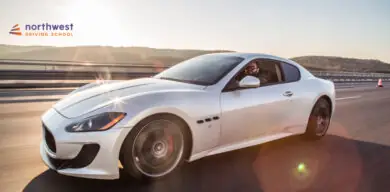- Driving School
When To Use Your Fog Lights

Your car’s fog lights are there to combat reduced visibility during the fall and winter months and keep you safe by making sure you and other motorists are visible. However, if you are using them incorrectly, you can, in fact, be putting yourself and other drivers in danger and could be breaking the law.
To help you know when and when not to use your fog lights, we’ve put together this quick guide.
Learn More About: Bad Weather Driving Tips
Table of Contents
What Is Fog?
In the general meteorological glossary fog is defined as ‘obscurity in the surface layers of the atmosphere, which is caused by a suspension of water droplets’.
According to the AA, by international agreement (particularly for aviation purposes) fog is the name given to resulting visibility less than 1 km. However, in forecasts for the public, this generally refers to visibility less than 180m.
Are Mist and Fog The Same Thing?
This is a common misconception, but no, they are not. As defined by the AA, Mist is ‘when there is such obscurity and the associated visibility is equal to or exceeds 1000 m.’ Like fog, the mist is still the result of the suspension of water droplets, but simply at a lower density.
Mist typically is quicker to dissipate and can rapidly disappear with even slight winds, it’s also what you see when you can see your breath on a cold day.
When Should You Use Your Car’s Fog Lights?
Many states have different law regarding the use of fog lights, but as a general rule:
Fog lights should only be used in the fog when visibility drops below 100 meters (328 feet) which is roughly the length of a football pitch.
If while driving in fog your car is involved in an accident and your fog lights weren’t in proper use, it could invalidate your insurance.
The use of front and rear fog lights to dazzle other drivers when visibility is not reduced or when the vehicle is parked is considered dangerous or reckless driving in most states and comes with a fine and possible suspension of your license.
Even if visibility is low, the use of fog lights in drizzle and rain is not allowed. This is because light is not reflected by rain in the same way that it is with fog. If you need extra visibility while driving at night in the rain the use your full beams. Just remember to switch back to dipped headlights when you see another car coming towards you on the other side of the road or driving ahead of you in the same direction.
Do not use your full beam headlights in the daytime, even in poor visibility. That is what your dipped headlights are for.
Tips For Driving In Foggy Conditions
If you think you are about to enter the fog, you should check your mirrors and then slow down. Slow speeds save lives in reduced visibility where the difference of a few miles per hour can be the difference between life and death.
A person hit by a car traveling at 30 Mph is 40% more likely to survive than a person who is hit by a car traveling at 40 Mph. When driving in fog or rain, the posted speed limit is often too fast and does not give you enough time to react in low visibility conditions or on a slippery road surface.
The recommended distance between you and the car in front is two seconds of drive time. In foggy conditions, you’ll need to extend that to four seconds of drive time.
Fog means moisture buildup on your windscreen, do make sure to use your wipers and to keep your windscreen demisted to aid with visibility.
If you see ‘fog’ is shown on a roadside signal, but can’t see it yet, be prepared to drive into a sudden bank of fog or drifting, patchy fog.
If the conditions are advertised as foggy, make sure you know where your fog-light switch is before you set off.
Do not use your full beam lights in foggy conditions. The fog will reflect these brighter lights back at you, reducing your visibility even further.
Don’t attempt to navigate using the tail lights of the car in front. Fog makes it very hard to just distance properly and using the lights in front of you can give you a false sense of security. The person in front of you might also be in the process of driving off a bridge.
Northwest Driving School Trusted In Nevada
The Northwest Driving School and Traffic School provide the Las Vegas community with live driving and traffic classes taught by seasoned instructors. All of our driving instructors have passed background checks, each automobile is DMV safety-approved and every member of the Northwest family is committed to providing excellent drivers ed and behind the wheel instruction.
At Northwest, you can expect to find outstanding classes, both on campus and behind the wheel, that are engaging, fact-filled, entertaining and geared toward success. We make no bones about it, we believe that Northwest provides the best driving lessons in Las Vegas, no matter your age or background. We are proud of the fact that 98% of our students pass their test on the first try. Call us at (702) 403-1592 to start your driving adventure with one of our expert instructors.
Written by:
Rich Heinrich
Master Instructor, Emeritus




